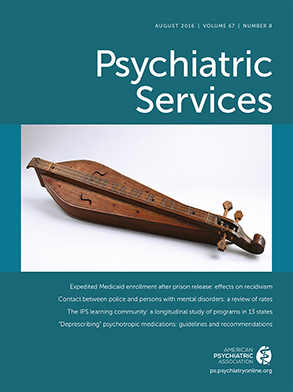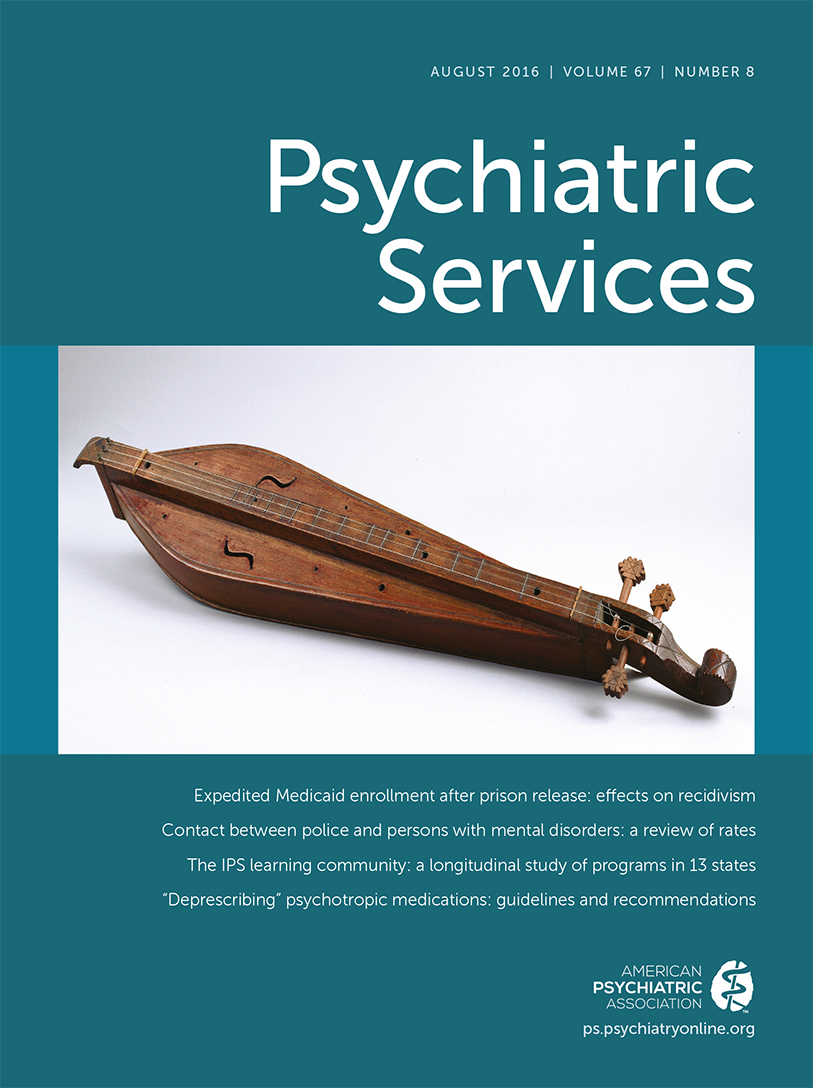Autism spectrum disorder (ASD) is a neurodevelopmental disorder caused by a combination of genetic and environmental influences. ASD is characterized, in varying degrees, by communication difficulties, social and behavioral challenges, and repetitive behaviors (
1,
2). More children than ever before are being classified as having ASD. The Centers for Disease Control and Prevention estimated in 2010 that one in 68 children receive an ASD diagnosis in the United States (
3). ASD has emerged as a major focus of public health concerns in this country, and an increasing number of families seek educational, social, and health care services to deal with its widespread impact (
4). Children with ASD have complex health care needs that require multiple types of specialized health care services (
5,
6). Behavioral interventions, including some developmental therapies, have been shown to be effective and are often recommended in treating ASD (
7,
8).
National data indicate that a research gap exists in understanding how insurance coverage types affect use of health services for children with ASD. One study based on a national survey in 1999 found that parents who had Medicaid coverage for children with autism or other types of special health care needs were less likely to encounter problems with access to care (
9). Another study, conducted in Kentucky, showed that the proportion of out-of-pocket expenditures allocated to speech language therapy among publicly insured children with ASD was higher than expenditures for therapy among privately insured children (
10). A study using 2003 Medicaid data and the Market Scan Commercial Claims database indicated that Medicaid-enrolled children with ASD received many more services than those enrolled in private insurance (
11).
As of April 2016, 43 states and the District of Columbia have enacted health insurance reform laws for coverage of autism-related care. Health insurance policies in many states include coverage for speech, language, and occupational therapies for children with ASD (
12). However, these state insurance policies do not apply to the self-funded policies that large employers typically offer, which is the type of coverage carried by one-fourth of insured Americans (
13). There is a need to compare, using current national data, the use of health services among children with ASD with different types of health insurance. The purpose of this study was to examine the effects of insurance type on access to and utilization of health services for U.S. children with ASD.
Methods
The National Survey of Children’s Health (NSCH) is a cross-sectional telephone survey of U.S. households with children younger than 18 years. One child in each household is randomly selected to be the subject of the survey. The NSCH is funded by the Maternal and Child Health Bureau in partnership with the National Center for Health Statistics. The NSCH data files are publicly available from the center’s Web site and represent nationwide parent- or caregiver-reported information. Conducted February 28, 2011, through June 25, 2012, the NSCH includes questions about child and family demographic characteristics, health status, health insurance status, type of coverage, access to health care, and use of therapy for children with ASD.
This analysis focused on children with ASD from the ages of birth to 17 years. ASD was ascertained through a question to the parent or guardian: “Has a doctor or health professional ever told you that your child has autism?” The ASD group included all children whose family answered yes to that question. This analysis included information for 2,041 children with ASD. Families were considered uninsured if they said at the time of the interview that they were not covered by insurance. Public insurance coverage included insured families enrolled in Medicaid or the State Children’s Health Insurance Program (SCHIP), and private insurance coverage included health insurance plans run by private insurance companies.
The outcomes analyzed in this study were based on parent report on health insurance coverage, health care access, and use of therapies for children with ASD. For example, the question regarding the use of therapeutic services was asked as follows: “Has your child ever received therapy services to meet his/her developmental needs, such as early intervention, occupational therapy, speech therapy, or behavioral therapy?” The independent variable of interest was a binary variable indicating whether or not a child had Medicaid/SCHIP or private insurance as the payer of the child’s primary health plan. The following child and family characteristics were used as control variables in the analysis: age, gender, race (white, black, and other), child’s general health status (excellent to good or fair to poor), and parent’s level of education (less than high school, high school graduate, or more than high school). To account for the impact of the state autism health insurance legislation, also included as a control variable was whether the state where the respondent lived had such legislation. The specifics of autism insurance law vary from state to state, but such laws require health insurers to provide behavioral therapy to young children with autism.
Data analysis was conducted with SAS 9.4 statistical software. A chi square test was used to compare the key outcome variables for significant differences between two insurance types. Multivariate logistic regression analyses were conducted to determine the potential effects of insurance type on the indicators of access to and use of health care services between publicly and privately insured children with ASD. Analyses controlled for the variables of state autism reform (no reform or enacted for less than one year, one to less than three years, or three or more years) and child and family characteristics. Odds ratios (ORs) were used as a measure of association, and 95% confidence intervals were computed. All p values were two-sided, and p<.05 was deemed statistically significant. All the analyses were weighted to be nationally representative.
Results
A total of 95,677 children had valid data for the survey. Of 85,556 children with a valid response to the ASD question, 2,041 children were identified as ever receiving an ASD diagnosis. Nearly 98% of children with ASD had current insurance coverage at the time of the interview. About 44% of children with ASD had Medicaid or SCHIP. Eighty-one percent were male, 17% were less than six years old, 72% were white, 88% were reported by parents or guardians to be in good to excellent health, and 47% of the parents and guardians had more than a high school education.
Bivariate analyses were conducted to determine the adequacy of health insurance coverage; degree of family financial burden, difficulty paying bills for child’s health care, and frustration in obtaining health care services; and use of therapy for children with ASD, as reported by parents. Only 19% of families of publicly insured children with ASD indicated that their health insurance plan did not cover services to meet their needs, whereas 31% of families of privately insured children with ASD (p=.004) indicated the same. About 84% of families of privately insured children paid out-of-pocket medical expenses, compared with 32% of their publicly insured counterparts (p<.001). Nearly 33% of children with private insurance plans did not receive therapy, compared with 18% of children with public insurance (p<.001). No significant differences were found between privately and publicly insured children in families’ responses about having difficulty paying bills for their child’s health care or being frustrated in efforts to obtain health care services.
Table 1 presents adjusted results from the multivariate regression analysis in terms of adequacy of health plan benefits, out-of-pocket medical expenses, and the use of therapy. After analyses controlled for autism state legislation and other family and child characteristics, the odds of having any out-of-pocket medical expenses were nearly 11.0 times higher for families with private insurance than for families with public insurance (OR=10.76). Families with private health insurance were less likely than those with public health insurance to report that their health insurance covered needed services (OR=.52). The odds of receiving therapy were far lower for privately insured children than for publicly insured children (OR=.49). The odds of receiving therapy were significantly higher for families living in states that had enacted autism insurance laws for more than three years, compared with those without such legislation at the time of the survey.
Discussion and Conclusions
Based on the most current NSCH, these results suggest gaps in adequacy of care, family financial burden, and utilization of therapy for children with ASD dependent on whether families had public (Medicaid or SCHIP) or private insurance coverage. Compared with their publicly insured counterparts, families of privately insured children with ASD were significantly more likely to pay out-of-pocket medical expenses, less likely to have health insurance plans to cover needed care, and less likely to use speech, occupational, or behavioral therapies. These findings suggest that special attention should be directed to private insurance, where therapeutic services may be inadequately covered.
Consistent with previous studies using older data, in our study families of privately insured children with ASD experienced significantly greater financial burden for their children’s health care. This study, using recent national databases, provides evidence of the continuing inadequacy of private health insurance coverage in addressing therapeutic needs of U.S. children with ASD. This analysis also suggests that the decreased satisfaction either relates to the greater burdens and lack of coverage or to the possibility that families with private insurance may have different expectations from publicly insured families about what ASD services should entail. Early behavioral interventions, as well as speech, occupational, and physical therapies, are often recommended for children with ASD to support their development, participation, and learning (
14,
15). Expanding private insurance coverage, particularly in covering these services, might improve developmental outcomes for children with ASD.
The results also show the positive impact of the state autism health insurance reform on children receiving therapy. However, states that have enacted autism insurance reform laws are not required to offer the same autism benefits through the Affordable Care Act (ACA) plans. States will decide what ASD interventions and treatments insurance companies must cover. This analysis raises an important policy issue for implementation of health insurance reform legislation to provide therapy for children with ASD.
This study had several limitations. First, our cross-sectional methods measured type of insurance coverage at only one point in time using the NSCH data, without taking into account possible changes in insurance in years preceding the survey. Second, private insurance is a very heterogeneous mix even within a state, and thus our analyses may have obscured some of the subtle differences across insurance types. Third, the therapies were all grouped as one variable, without distinctions between them. Finally, bias may have been introduced by parent-reported data, in particular for subjective assessment.
Despite the limitations of this study, the impact of health insurance policy for children with ASD is an important and timely issue and an emerging area for health services research. Improving access to care for children with ASD is now contained within the implementation of the ACA, and future studies should examine the impact of these changing policies through longitudinal analyses using both quantitative and qualitative data, collected nationally, as well as comprehensive documents analysis for each state.

